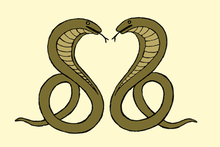Nagavanshi

The Nagavanshi (Sanskrit: नागवंशी nāgavaṃśī "of nāga-descent") or Nagavamshi dynasty were rulers in the area of the present Chhattisgarh state from around the 11th century CE to the 14th century.[1] A copper plate inscription from the Gupta Empire era relates that nāgas were elevated to the kshatriya caste.[2] The copper plates of this period relate to the Nagas being defeated by the Guptas and subsequently being married into them. One example is that of King Chandragupta II, who married Queen Kuberanaga. The Nagas were mentioned as an snake-worshipping tribe of ancient India.[3]
Nagavanshis Castes
The Nairs of Kerala and Bunts of Karnataka claim descent from the naga Śeṣa; these regions include the Nagavanshi clans who migrated from North India associated with the events referred to as the Sarpasatram. The Nairs were organized into various martial clans like Nambiar, Kiryathil Nair, Illathu Nair and Swaroopathil Nairs.[4][5][6][7][8] The Illathu, Swaroopathil and Kiryathil Nairs have been classified as Kshatriyas of the Nagavanshi lineage [9]Also claims as Nagavamsam in North costal region of Andhra pradesh state, where central government referred them under serial number 81 in NCBC (National Commission for Backward classed) (link: http://www.ncbc.nic.in/User_Panel/GazetteResolution.aspx?Value=mPICjsL1aLvYBtdZSrP4uO%2bploAhiJHMitEMCkgxxsH%2f7oa9L5Zf2o2HH3BmrgcE) Sl. No 81 pdf page no: 38.
See also
References
- ↑ Dasgupta, Samira; Amitabha Sarkar (2005). Reflection Of Ethno-science: Study On The Abujh Maria. Mittal Publications. p. 9. ISBN 978-8183240253.
- ↑ Tiwari 2002, p. 183.
- ↑ Tiwari 2002, p. 177-231.
- ↑ Ramananda Chatterjee (1907). The Modern Review. Prabasi Press Private, Ltd. p. 695.
- ↑ Dr. Hermann Gundert, Keralolpathiyum Mattum, (Band 4, Hermann Gundert Series, Eight works published during 1843-1904) (Kottayam: Current Books, 1992), p 185
- ↑ P. V. Balakrishnan (1981). Matrilineal system in Malabar. Satyavani Prakashan. p. 28.
- ↑ P. T. Srinivasa Iyengar (1929). History of the Tamils: from the earliest times to 600 A.D. Asian Educational Services. p. 93.
- ↑ Srikanteswaram G.Padmanabha Pillai (2009). Sabdatharavali, Edition 34. p. 1068.
- ↑ Hinduism. PediaPress.
Sources
- Tiwari, Shiv Kumar (2002), Tribal Roots Of Hinduism, Sarup & Sons